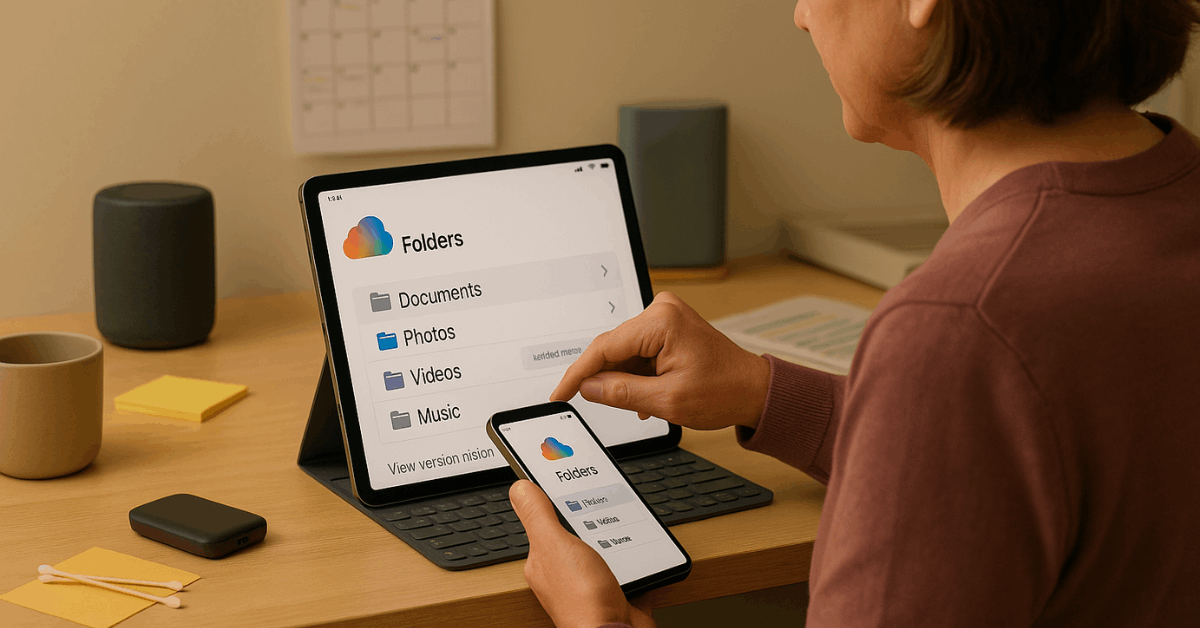In homes and offices everywhere, oversized photo libraries, app caches, and duplicate files steadily consume storage.
Under tight device limits, the fastest relief often comes when you Use Cloud Storage to Save Space without sacrificing access, security, or collaboration.
In practice, cloud platforms offload bulky folders to remote servers, keep lightweight placeholders locally, and sync on demand, so daily workflows stay quick while storage pressure drops.

What Cloud Storage Is and Why It Frees Space
Cloud storage moves originals to secure data centers and leaves small pointers on your device. When a file is opened, the current version streams or downloads as needed, then re-syncs changes back to the cloud.
Because heavy media folders migrate off-device, local free space rebounds quickly, especially on thin-storage phones and ultrabooks, this model also reduces reliance on fragile USB sticks and external drives that add clutter and fail without warning.
Benefits that Matter Day to Day
Cloud storage improves more than raw capacity. Faster setup, simpler collaboration, and resilient protection combine to raise productivity while lowering risk. Clear gains appear immediately on limited-storage phones and shared family laptops, while distributed teams profit from versioned collaboration and consistent access.
- Accessibility anywhere: Files open from any signed-in device, minimizing email attachments and risky side loads.
- Scalability on demand: Plans expand in small increments, aligning cost to actual growth rather than guesses.
- Security layers: Encryption at rest and in transit, plus multifactor authentication, lower takeover risk significantly.
- Team collaboration: Shared folders, comments, and granular permissions enable secure file sharing without messy duplicates.
- Resilience: Version history and recycle bins speed recovery from mistakes, ransomware, or sync conflicts.
Step-by-Step: Set Up and Start Saving Space
Clear steps prevent clutter during migration and keep sync stable across phones and laptops. A focused setup ensures the right folders move first, offline files remain available, and permissions avoid accidental exposure for family members or coworkers.
- Choose a provider that fits needs: Compare cloud storage pricing plans, cross-device apps, zero-knowledge options, and admin controls if a team will join.
- Install desktop and mobile apps: Sign in, confirm default sync folders, and enable sign-in alerts alongside strong multifactor authentication.
- Select folders to migrate first: Move Photos, Videos, and bulky project archives; enable “online-only” or “free up space” to reduce hard drive space immediately.
- Enable smart sync or placeholders: Keep a mirrored structure locally while storing large originals in the cloud to accelerate launches and searches.
- Test restore paths: Recover a prior file via version history recovery and retrieve a deleted item from the trash to validate protection.
Organize, Sync, and Share Without Clutter
Consistent names and a shallow hierarchy speed search, prevent duplicates, and make onboarding painless. Create a top-level structure that groups Work, Personal, Media, and Archives, then apply YYYY-MM naming for projects and trips.
Because search indexes thrive on predictable names, short prefixes like “INV_2025-Q3” or “VID_India-2024” simplify filtering across thousands of items. Tags, comments, and link descriptions also help collaborators identify the right file quickly.
Set link defaults to view-only, add expirations for external shares, and invite editors only when active changes are expected. For recurring handoffs, shared folders beat single-file links because permissions and versioning remain intact during ongoing edits and reviews.
Backup and Recovery Features That Prevent Loss
Strong recovery turns simple syncing into true protection. Evaluating these settings early avoids frantic troubleshooting after an incident and shortens downtime during ransomware or device theft.
- Automatic backup schedules: Continuous or hourly backups capture silent changes that manual routines frequently miss.
- File versioning Windows: Rolling histories preserve earlier drafts, enabling rapid rollback after bad edits or corrupt saves.
- Recycle bin retention: Deleted items remain recoverable for a defined period, limiting damage from accidental removals.
- Snapshots of entire sets: Point-in-time snapshots speed broad recovery after malware, syncing storms, or mass deletions.
- Cross-device coverage: Unified plans that include mobiles and externals simplify file sync and backup across the full fleet.
Privacy, Security, and Compliance Basics
Turn on multifactor authentication, set alerts for new sign-ins, and restrict legacy protocols that bypass modern checks. Because data protection rules vary by location and sector, confirm provider documentation for GDPR in the EU and CCPA in the U.S., and request Data Processing Agreements when handling personal data.
For sensitive work, evaluate client-side encryption where keys are held by the customer, then document key-management procedures so recovery remains possible after staffing changes.
Access control deserves equal rigor. Assign the minimum necessary privileges, expire external links upon project completion, and audit shares quarterly. Because mobile devices are frequent leak sources, enforce device passcodes, biometrics, and encrypted backups, then enable remote-wipe options for lost phones.
Choosing a Provider: Quick Comparison Pointers
Feature fit matters more than brand recognition. Narrow the shortlist using compatibility, governance, and performance criteria, then trial on real files before committing. The following prompts help focus testing and avoid surprises during rollout.
| Criterion | What to check quickly |
| Device support | Stable cross-platform cloud apps for Windows, macOS, Android, iOS, and optional Linux. |
| Space efficiency | Online-only placeholders and one-click “free up space” to reclaim gigabytes fast. |
| Recovery depth | Versioning length, snapshot cadence, and trash retention under real workloads. |
| Security posture | MFA options, encryption model, link expirations, and admin audit trails. |
| Cost alignment | Tier steps, archive tiers, and egress limits inside cloud storage pricing plans. |

Space-Saving Tips for Phones and Laptops
Practical tweaks amplify reclaimed space and keep performance steady during heavy weeks or travel. Short monthly habits prevent bloat while preserving access to important media and work assets.
- Turn on camera uploads with optimization: Keep full-resolution images in the cloud and device-optimized copies locally to optimize phone storage safely.
- Archive inactive projects: Convert finished work to online-only, tag the archive date, and snapshot the folder once for easy compliance checks.
- Stream media from the cloud: Play long videos and raw photo sets directly, downloading only final exports or current edits.
- Target cache and exports: Clear app caches, temp exports, and duplicate downloads after publishing or client delivery cycles.
- Schedule quarterly reviews: Remove redundant renders and outdated installers, then confirm that active notebooks still sync correctly.
Common Pitfalls to Avoid
Skipping a naming convention guarantees future duplicates and slow searches, while over-permissive links leak drafts and personal data.
Leaving devices out of scope creates gaps where local folders never back up, causing partial histories and missed restores.
Ignoring restore drills also invites panic later, since incident recovery depends on comfort with versioning, snapshots, and granular link audits. Finally, delaying plan upgrades increases risk when accounts hover near capacity, because full drives and saturated quotas silently break sync and stall collaboration.
Conclusion
Modern workflows run smoother when storage is centralized, recoverable, and accessible on demand.
Apply a clear structure, enforce strong access controls, and keep online-only placeholders active to Use Cloud Storage to Save Space without slowing down daily work. Because capacity and features scale cleanly, households, freelancers, and teams can start small, validate recovery, and expand confidently as libraries grow.
Adopt cloud storage best practices, test restores quarterly, and maintain disciplined sharing rules so collaboration remains fast, private, and durable over time.












